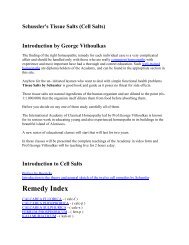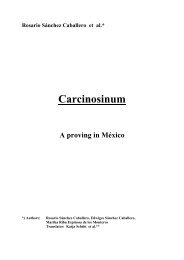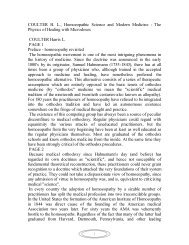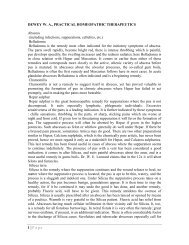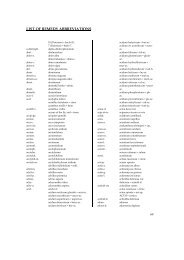B.nninghausen Article.cdr - Hpathy
B.nninghausen Article.cdr - Hpathy
B.nninghausen Article.cdr - Hpathy
Create successful ePaper yourself
Turn your PDF publications into a flip-book with our unique Google optimized e-Paper software.
simple alphabetical listing of symptoms,<br />
various categorisations were proposed<br />
based on the principal characterising<br />
dimensions of symptoms (stipulated in<br />
8<br />
the Organon ), and several<br />
(Bö<strong>nninghausen</strong>, Jahr, Hering, Gross,<br />
Rückert, among others) applied<br />
themselves to how that might be<br />
translated into various forms of<br />
9<br />
reference in their own individual ways.<br />
The principal characterising dimensions<br />
which Bö<strong>nninghausen</strong> used to structure<br />
his repertories, and used to greatest<br />
effect in the Therapeutic Pocketbook,<br />
were according to location, sensation,<br />
modalities and accessory symptoms (or<br />
concomitants). These four dimensions,<br />
particularly the last, have to a large<br />
extent become synonymous with the<br />
“Bö<strong>nninghausen</strong> Method”, largely due<br />
to H A Roberts who repeatedly asserted<br />
in the introductions he wrote to later<br />
10<br />
editions of Bö<strong>nninghausen</strong>'s work that<br />
it was Bö<strong>nninghausen</strong> who evolved the<br />
“doctrine of concomitants”. But this was<br />
11<br />
simply taken directly from the Organon<br />
and was by no means uniquely<br />
Bö<strong>nninghausen</strong>'s thinking. Hering<br />
published an article in Stapf's Archiv in<br />
1832 in which he proposed an identical<br />
schema. 12<br />
Symptom Combinations<br />
The feature which mostly distinguishes<br />
the “Bö<strong>nninghausen</strong> Method” from<br />
other applications of Hahnemann's<br />
principles is the idea of recombining the<br />
component parts of symptoms in order<br />
to reflect the totality of the patient.<br />
As Stuart Close remarked: “The Totality<br />
is an ideal not always to be realised. As a<br />
matter of fact, in practical experience, it<br />
is often impossible to complete every<br />
symptom, or even a large part of the<br />
symptoms. Patients have not observed,<br />
or cannot state all these points. They will<br />
give fragments; the location of a<br />
sensation which they cannot describe,<br />
or a sensation which they cannot locate;<br />
or they will give a sensation, properly<br />
located, but without being able, through<br />
ignorance, stupidity, failure to observe or<br />
forgetfulness, to state the conditions of<br />
time and circumstances under which it<br />
appeared. Sometimes no amount of<br />
questioning will succeed in bringing out<br />
the missing elements of some of the<br />
13<br />
symptoms.”<br />
While working on amalgamating and<br />
updating his earlier repertories, which<br />
had also been developed in close<br />
Clemens Maria Franz von Bö<strong>nninghausen</strong> (1785-1864) came to<br />
homeopathy relatively late in life after being cured of tuberculosis at the<br />
14<br />
age of 43. According to Gross, the remedy was Pulsatilla. His family<br />
were one of the oldest of the nobility of Rhineland and Westphalia,<br />
though of relatively moderate means. He initially trained as a lawyer and<br />
was invited to join the Dutch State service at the court of Louis<br />
Napoléon, King of Holland, where his talents were recognised in a<br />
succession of rapid promotions until the king's abdication in 1810. From<br />
the age of 25, he devoted himself to agriculture and had a reputation for<br />
his extensive botanical knowledge, though he returned to State service as<br />
the President of the Provincial Court of Justice for Westphalia in 1816<br />
and became General Commissioner for the land-register of the Rhineland<br />
15<br />
and Westphalia in 1822. Following his cure from tuberculosis in 1828,<br />
he threw himself into the study of homeopathy and became a regular<br />
correspondent of Hahnemann's, an energetic prover, and gathered<br />
considerable fame as a practitioner, all while continuing to travel<br />
extensively in the service of the State. At the age of 58 he was granted<br />
authority to practice medicine (without a medical examination) by order<br />
of the Cabinet of King Friedrich Wilhelm IV, and retired from State<br />
service immediately to devote himself entirely to homeopathy, which he<br />
practiced for a further 21 years. He had an enormous practice. It's<br />
estimated from his 112 bulky quarto volumes of case records that he saw<br />
16<br />
3-4 times the number of patients seen by Hahnemann himself.<br />
Bö<strong>nninghausen</strong> had the distinction of publishing the first repertory, the<br />
Repertory of the Antipsoric Remedies, with a preface by Hahnemann, in<br />
1832. It sold out very quickly, prompting a second edition in 1833 which<br />
was retitled Systematic Alphabetical Repertory of Homeopathic<br />
Remedies, First Part, again with an introduction – or, more accurately, a<br />
treatise on olfaction – by Hahnemann. This was followed by the<br />
Repertory of Medicines which are not Antipsoric (or Systematic<br />
Alphabetical Repertory of Homeopathic Remedies, Second Part) in 1835.<br />
The Therapeutic Pocketbook for Homeopathic Physicians for use at the<br />
Bedside and the Study of Materia Medica Pura was published in 1846.<br />
Hahnemann wrote about him “…if I should be ill myself and unable to<br />
17<br />
help myself I would not entrust myself to any other physician.” His<br />
contempories described him as “…one of the first master minds of<br />
18<br />
homeopathic science.”




